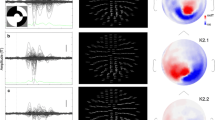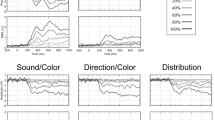Abstract
The retinal periphery of nine healthy subjects was stimulated with computer-generated random-dot kinematograms. These stimuli provided almost isolated visual motion information and minimal position cues. Pattern-reversal stimuli at the same location in the visual field were used for control. Stimulus-related electrical brain activity was recorded from 29 scalp electrodes. Total mean and individual data were analyzed with a spatiotemporal multiple dipole model. The scalp potentials showed a different spatial distribution for motion and pattern stimulation in the time range of 160–200 ms. In this epoch, the predominant motion-related source activity was localized in the region of the contralateral occipital-temporal-parietal border. A significant ipsilateral source activity was not found. The predominant source activity related to the pattern stimulus occurred in the same epoch. The corresponding equivalent dipole was localized more medially and deeper in the brain. The orientation of these major dipole activities was markedly different. These dipoles appeared to represent activity of distinct extrastriate areas, in contrast to earlier activity which was modelled by more posterior dipoles in the occipital lobe. The latter dipoles were at comparable contralateral locations and had similar peak activities around 100 ms, suggesting an origin in the striate cortex.
Similar content being viewed by others
References
Allman J, Miezin F, McGuiness E (1985) Directionand velocityspecific responses from beyond the classical receptive field in the middle temporal visual area (MT). Exp Brain Res 14:105–126
Baumgartner C, Barth DS, Levesque MF, Sutherling WW (1991) Functional anatomy of human hand sensorimotor cortex from spatiotemporal analysis of electrocorticography. Electroencephalogr Clin Neurophysiol 78:56–65
Berg P, Scherg M (1991) Dipole models of eye movements and blinks. Electroencephalogr Clin Neurophysiol 79:36–44
Clarke S, Miklossy J (1990) Occipital cortex in man: organization of callosal connections, related myeloand cytoarchitecture, and putative boundaries of functional visual areas. J Comp Neurol 298:188–214
Cohen D, Cuffin BN, Yunokuchi K, Maniewski R, Purcell C, Cosgrove GR, Ives J, Kennedy JG, Schomer DL (1990) MEG versus EEG localization test using implanted sources in the human brain. Ann Neurol 28:811–817
Cuffin BN, Cohen D, Yunokuchi K, Maniewski R, Purcell C, Cosgrove GR, Ives J, Kennedy JG, Schomer DL (1991) Test of EEG localization accuracy using implanted sources in the human brain. Ann Neurol 29:132–138
Cunningham VJ, Deiber MP, Frackowiak RSJ, Friston KJ, Kennard C, Lammertsma A, Lueck CJ, Romaya J, Zeki S (1990) tThe motion area (area V5) of human visual cortex. J Physiol (Lond) 423:101P
Ebersole JS (1991) EEG dipole modelling in complex partial epilepsy. Brain Topogr 4:113–123
Fiorani M, Gattass R, Rosa MGP, Sousa APB (1989) Visual area MT in the Cebus monkey: location, visuotopic organization, and variability. J Comp Neurol 287:98–118
Gattass R, Gross CG (1981) Visual topography of striate projection zone (MT) in posterior superior temporal sulcus of the Macaque. J Neurophysiol 46:621–638
Leenders KL, Gibbs JM, Frackowiak RSJ, Lammertsma AA, Jones T (1984) Positron emission tomography of the brain: new possibilities for the investigation of human cerebral pathophysiology. Prog Neurobiol 23:1–38
Maier J, Dagnelie H, Spekreijse H, Dijk BW van (1987) Principal components analysis for source localization of VEPs in man. Vision Res 27:165–177
Newsome WT, Paré EB (1988) A selective impairment of motion perception following lesions of the middle temporal visual area (MT). J Neurosci 8:2201–2211
Newsome WT, Wurtz RH, Dürsteler MR, Mikami A (1985) Deficits in visual motion processing following ibotenic acid lesions of the middle temporal visual area of the Macaque monkey. J Neurosci 5:825–840
Probst Th, Wist ER (1990) Electrophysiological evidence for visualvestibular interaction in man. Neurosci Lett 108:255–260
Probst Th, Krafczyk S, Brandt Th, Wist ER (1984) Interaction between perceived self-motion and object-motion impairs vehicle guidance. Science 225:536–538
Scherg M (1990) Fundamentals of dipole source potential analysis. In: Grandori F, Hoke M, Romani GL (eds) Auditory evoked magnetic fields and electric potentials. Adv Audiol 6:40–69
Scherg M, Berg P (1991) Use of prior knowledge in brain electromagnetic source analysis. Brain Topogr 4:143–150
Scherg M (1992) Functional imaging and localization of electromagnetic brain activity. Brain Topogr 5:103–111
Scherg M, Cramon D von (1985a) A new interpretation of the generators of BAEP waves I–V: results of a spatiotemporal dipole model. Electroencephalogr Clin Neurophysiol 62:290–299
Scherg M, Cramon D von (1985b) Two bilateral sources of the late AEP as identified by a spatiotemporal dipole model. Electroencephalogr Clin Neurophysiol 62:32–44
Scherg M, Cramon D von (1986) Evoked dipole source potentials of the human auditory cortex. Electroencephalogr Clin Neurophysiol 65:344–360
Scherg M, Picton TW (1991) Separation and identification of event related potential components by brain electric source analysis. EEG [Suppl 42]:24–37
Scherg M, Vajsar J, Picton TW (1989) A source analysis of the late human auditory evoked potentials. J Cogn Neurosci 1:336–355
Simpson GV, Scherg M, Ritter W, Vaughan HG (1990) Localization and temporal activity functions of brain sources generating the human visual ERP. In: Brunia CHM, Gaillard AWK, Kok A (eds) Psychophysical brain research. Tilburg University Press, Tilburg, pp 99–105
Thurston SE, Leigh RJ, Crawford T, Thompson A, Kennard C (1988) Two distinct deficits of visual tracking caused by unilateral lesions of cerebral cortex in humans. Ann Neurol 23:266–273
Vaina LM (1989) Selective impairment of visual motion interpretation following lesions of the right occipitoparietal area in humans. Biol Cybern 61:347–359
Vaina LM, Lemay M, Bienfang DC, Choi AY, Nakayama K (1990) Intact “biological motion” and “structure from motion” perception in a patient with impaired motion mechanisms: a case study. Visual Neurosci 5:353–369
Zeki SM (1969) Representation of central visual fields in prestriate cortex of monkey. Brain Res 14:271–291
Zeki SM (1974) Functional organization of a visual area in the posterior bank of the superior temporal sulcus of the Rhesus monkey. J Physiol (Lond) 236:549–573
Zeki SM (1980) The response properties of cells in the middle temporal area (area MT) of owl monkey visual cortex. Proc R Soc Lond [Biol] 207:239–248
Zeki SM (1991) Cerebral akinetopsia (visual motion blindness). Brain 114:811–824
Zeki SM, Watson JDG, Lueck CJ, Friston KJ, Kennard C, Frackowiak RSJ (1991) A direct demonstration of functional specialization in human visual cortex. J Neurosci 11:641–649
Zihl J, Cramon D von, Mai N (1983) Selective disturbance of movement vision after bilateral brain damage. Brain 106:313–340
Author information
Authors and Affiliations
Rights and permissions
About this article
Cite this article
Probst, T., Plendl, H., Paulus, W. et al. Identification of the visual motion area (area V5) in the human brain by dipole source analysis. Exp Brain Res 93, 345–351 (1993). https://doi.org/10.1007/BF00228404
Received:
Accepted:
Issue Date:
DOI: https://doi.org/10.1007/BF00228404




